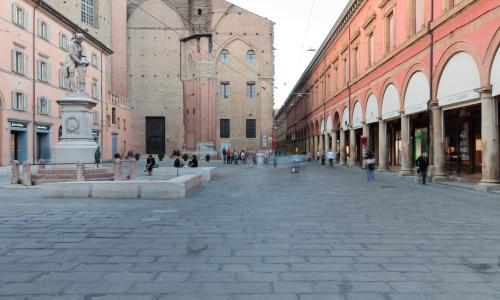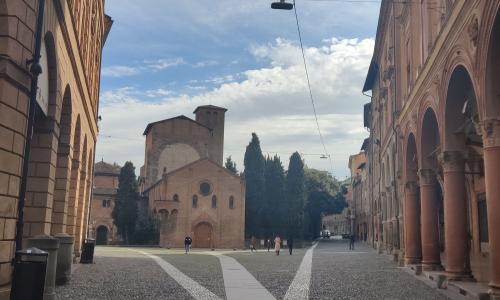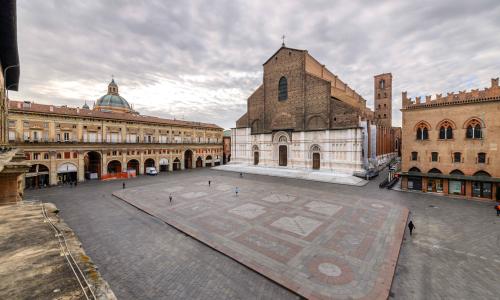Maps
Squares

Piazza Galvani
The square was inaugurated by Pope Pius IV in coincidence with the construction of the portico and the Archiginnasio building in 1563. This property had already hosted the silk cocoon trade fair; hence the name Piazza del Pavaglione derives from the word ‘pavilion’ - the shelters under which this event was held.
In 1801, to celebrate the Lunéville peace between France and Austria, two countries that competed for dominion over the Emilian territories, the property is named Piazza della Pace, but this name did not take root.
In 1871 the square was dedicated to the scientist Luigi Galvani, depicted in the statue by the sculptor Adalberto Cencetti (1879) that dominates the square.
In 1801, to celebrate the Lunéville peace between France and Austria, two countries that competed for dominion over the Emilian territories, the property is named Piazza della Pace, but this name did not take root.
In 1871 the square was dedicated to the scientist Luigi Galvani, depicted in the statue by the sculptor Adalberto Cencetti (1879) that dominates the square.
Read more

Piazza Galvani
The square was inaugurated by Pope Pius IV in coincidence with the construction of the portico and the Archiginnasio building in 1563. This property had already hosted the silk cocoon trade fair; hence the name Piazza del Pavaglione derives from the word ‘pavilion’ - the shelters under which this event was held.
In 1801, to celebrate the Lunéville peace between France and Austria, two countries that competed for dominion over the Emilian territories, the property is named Piazza della Pace, but this name did not take root.
In 1871 the square was dedicated to the scientist Luigi Galvani, depicted in the statue by the sculptor Adalberto Cencetti (1879) that dominates the square.
In 1801, to celebrate the Lunéville peace between France and Austria, two countries that competed for dominion over the Emilian territories, the property is named Piazza della Pace, but this name did not take root.
In 1871 the square was dedicated to the scientist Luigi Galvani, depicted in the statue by the sculptor Adalberto Cencetti (1879) that dominates the square.
Read more

Piazza Santo Stefano
Piazza Santo Stefano does not exist. What everyone refers to as a "square" is, in actual fact, a widening of the road at the end of the façade of the homonymous church, originally composed of an aggregate of liturgical spaces referred to by the Bolognese population as the "Sette Chiese".
This space has a distinct "funnel" shape and connects points at different heights, filling the difference in height between the lower centre, the entrance of the church which is even lower and the porticoed sides which are higher. In 1934 it was decided to overcome these differences in heights: the churchyard was isolated in a lowered area, around which a plinth was built, taking the floor plane to the level of the highest point. The square was then accessible for vehicles and pedestrians all around the church and this is how it remained until the 1980s. In 1989, Dino Gavina, a knowledgeable entrepreneur, convinced the local authorities to involve Luigi Caccia Dominioni. The project by the Milan based architect plans to restore the bowl shape of the square crossed by ‘guidane’ i.e. pedestrian paths indicated by paving that is different from the main one used.
This space has a distinct "funnel" shape and connects points at different heights, filling the difference in height between the lower centre, the entrance of the church which is even lower and the porticoed sides which are higher. In 1934 it was decided to overcome these differences in heights: the churchyard was isolated in a lowered area, around which a plinth was built, taking the floor plane to the level of the highest point. The square was then accessible for vehicles and pedestrians all around the church and this is how it remained until the 1980s. In 1989, Dino Gavina, a knowledgeable entrepreneur, convinced the local authorities to involve Luigi Caccia Dominioni. The project by the Milan based architect plans to restore the bowl shape of the square crossed by ‘guidane’ i.e. pedestrian paths indicated by paving that is different from the main one used.
Read more

Piazza Santo Stefano
Piazza Santo Stefano does not exist. What everyone refers to as a "square" is, in actual fact, a widening of the road at the end of the façade of the homonymous church, originally composed of an aggregate of liturgical spaces referred to by the Bolognese population as the "Sette Chiese".
This space has a distinct "funnel" shape and connects points at different heights, filling the difference in height between the lower centre, the entrance of the church which is even lower and the porticoed sides which are higher. In 1934 it was decided to overcome these differences in heights: the churchyard was isolated in a lowered area, around which a plinth was built, taking the floor plane to the level of the highest point. The square was then accessible for vehicles and pedestrians all around the church and this is how it remained until the 1980s. In 1989, Dino Gavina, a knowledgeable entrepreneur, convinced the local authorities to involve Luigi Caccia Dominioni. The project by the Milan based architect plans to restore the bowl shape of the square crossed by ‘guidane’ i.e. pedestrian paths indicated by paving that is different from the main one used.
This space has a distinct "funnel" shape and connects points at different heights, filling the difference in height between the lower centre, the entrance of the church which is even lower and the porticoed sides which are higher. In 1934 it was decided to overcome these differences in heights: the churchyard was isolated in a lowered area, around which a plinth was built, taking the floor plane to the level of the highest point. The square was then accessible for vehicles and pedestrians all around the church and this is how it remained until the 1980s. In 1989, Dino Gavina, a knowledgeable entrepreneur, convinced the local authorities to involve Luigi Caccia Dominioni. The project by the Milan based architect plans to restore the bowl shape of the square crossed by ‘guidane’ i.e. pedestrian paths indicated by paving that is different from the main one used.
Read more

Piazza Maggiore
The heart of Bologna. This is the Platea communis, the town square created in the thirteenth century to house the City Council chambers in the Town Hall, Palazzo del Podestà and Palazzo dei Notai. In 1390, Basilica of San Petronio was built, a civic temple commissioned by the citizens, and the scenic backdrop of the Palazzo dei Banchi, behind which the cluttered area of the Mercato di Mezzo extends.
The centre of the square has a raised area called "Crescentone" which has always hosted the market. In the nineteenth century the statue of King Vittorio Emanuele was erected there and was later moved to the Giardini Margherita park. The area teemed with the jeeps of the allies who liberated Bologna on 21 April 1945 and with dense traffic in the years after, until it was decided to make the zone a pedestrian thoroughfare. For many years now, in the summer the area has abounded with film enthusiasts who, with their eyes fixed on a screen as large as a building, animate the open-air screening organised by the Cineteca di Bologna and which is now of international importance.
The centre of the square has a raised area called "Crescentone" which has always hosted the market. In the nineteenth century the statue of King Vittorio Emanuele was erected there and was later moved to the Giardini Margherita park. The area teemed with the jeeps of the allies who liberated Bologna on 21 April 1945 and with dense traffic in the years after, until it was decided to make the zone a pedestrian thoroughfare. For many years now, in the summer the area has abounded with film enthusiasts who, with their eyes fixed on a screen as large as a building, animate the open-air screening organised by the Cineteca di Bologna and which is now of international importance.
Read more

Piazza Maggiore
The heart of Bologna. This is the Platea communis, the town square created in the thirteenth century to house the City Council chambers in the Town Hall, Palazzo del Podestà and Palazzo dei Notai. In 1390, Basilica of San Petronio was built, a civic temple commissioned by the citizens, and the scenic backdrop of the Palazzo dei Banchi, behind which the cluttered area of the Mercato di Mezzo extends.
The centre of the square has a raised area called "Crescentone" which has always hosted the market. In the nineteenth century the statue of King Vittorio Emanuele was erected there and was later moved to the Giardini Margherita park. The area teemed with the jeeps of the allies who liberated Bologna on 21 April 1945 and with dense traffic in the years after, until it was decided to make the zone a pedestrian thoroughfare. For many years now, in the summer the area has abounded with film enthusiasts who, with their eyes fixed on a screen as large as a building, animate the open-air screening organised by the Cineteca di Bologna and which is now of international importance.
The centre of the square has a raised area called "Crescentone" which has always hosted the market. In the nineteenth century the statue of King Vittorio Emanuele was erected there and was later moved to the Giardini Margherita park. The area teemed with the jeeps of the allies who liberated Bologna on 21 April 1945 and with dense traffic in the years after, until it was decided to make the zone a pedestrian thoroughfare. For many years now, in the summer the area has abounded with film enthusiasts who, with their eyes fixed on a screen as large as a building, animate the open-air screening organised by the Cineteca di Bologna and which is now of international importance.
Read more

Piazza Cavour
It is an integral part of the component with a marked post-Unification identity and acquired its name upon the death of the statesman Camillo Benso, which occurred at the same time the square was designed.
Considered the city’s parlour since its construction, the square is the result of transformations taken place between 1859 and 1866 under the aegis of the first technical office of Bologna of the united Italy, guided by the engineer Coriolano Monti.
In truth, the origin dates to the final moments of papal management and to the aims of grandeur of Count Grabinski, owner of Palazzo Ruini Ranuzzi who wanted to widen the service road to his property and connect it to the throbbing heart of the old town centre. The difficulties Monti encountered once he took office pushed him to speed up the process. At one point he worked by night to level one of the buildings blocking the start of the new road. At this point, the two buildings at the centre of the debate were definitively sacrificed, inflicting great damage on the city's heritage. In fact, there was a remarkable cycle of frescoes by Lodovico Carracci inside one of the buildings, the Benati home. It was quickly removed, but is now mostly lost, with only one extant panel that can be seen today in the Reference Hall of the Archiginnasio Library.
The buildings that still surround it today began to take shape in 1861 with the new widening of the road. To the east is Palazzo Guidotti (already existing but pared down to regularise its façade) and the Palazzine Bottrigari. On the south side is Palazzo Silvani, the Palazzo of the Bank of Italy is to the west and, to the north is the building that in 1927 was to become Banca di Napoli.
Indeed, together with the not-too-distant Cassa di Risparmio, this city section is distinguished precisely by the presence of numerous banks, which over the years has imparted a tone of decorum and sober monumentality.
Considered the city’s parlour since its construction, the square is the result of transformations taken place between 1859 and 1866 under the aegis of the first technical office of Bologna of the united Italy, guided by the engineer Coriolano Monti.
In truth, the origin dates to the final moments of papal management and to the aims of grandeur of Count Grabinski, owner of Palazzo Ruini Ranuzzi who wanted to widen the service road to his property and connect it to the throbbing heart of the old town centre. The difficulties Monti encountered once he took office pushed him to speed up the process. At one point he worked by night to level one of the buildings blocking the start of the new road. At this point, the two buildings at the centre of the debate were definitively sacrificed, inflicting great damage on the city's heritage. In fact, there was a remarkable cycle of frescoes by Lodovico Carracci inside one of the buildings, the Benati home. It was quickly removed, but is now mostly lost, with only one extant panel that can be seen today in the Reference Hall of the Archiginnasio Library.
The buildings that still surround it today began to take shape in 1861 with the new widening of the road. To the east is Palazzo Guidotti (already existing but pared down to regularise its façade) and the Palazzine Bottrigari. On the south side is Palazzo Silvani, the Palazzo of the Bank of Italy is to the west and, to the north is the building that in 1927 was to become Banca di Napoli.
Indeed, together with the not-too-distant Cassa di Risparmio, this city section is distinguished precisely by the presence of numerous banks, which over the years has imparted a tone of decorum and sober monumentality.
Read more

Piazza Cavour
It is an integral part of the component with a marked post-Unification identity and acquired its name upon the death of the statesman Camillo Benso, which occurred at the same time the square was designed.
Considered the city’s parlour since its construction, the square is the result of transformations taken place between 1859 and 1866 under the aegis of the first technical office of Bologna of the united Italy, guided by the engineer Coriolano Monti.
In truth, the origin dates to the final moments of papal management and to the aims of grandeur of Count Grabinski, owner of Palazzo Ruini Ranuzzi who wanted to widen the service road to his property and connect it to the throbbing heart of the old town centre. The difficulties Monti encountered once he took office pushed him to speed up the process. At one point he worked by night to level one of the buildings blocking the start of the new road. At this point, the two buildings at the centre of the debate were definitively sacrificed, inflicting great damage on the city's heritage. In fact, there was a remarkable cycle of frescoes by Lodovico Carracci inside one of the buildings, the Benati home. It was quickly removed, but is now mostly lost, with only one extant panel that can be seen today in the Reference Hall of the Archiginnasio Library.
The buildings that still surround it today began to take shape in 1861 with the new widening of the road. To the east is Palazzo Guidotti (already existing but pared down to regularise its façade) and the Palazzine Bottrigari. On the south side is Palazzo Silvani, the Palazzo of the Bank of Italy is to the west and, to the north is the building that in 1927 was to become Banca di Napoli.
Indeed, together with the not-too-distant Cassa di Risparmio, this city section is distinguished precisely by the presence of numerous banks, which over the years has imparted a tone of decorum and sober monumentality.
Considered the city’s parlour since its construction, the square is the result of transformations taken place between 1859 and 1866 under the aegis of the first technical office of Bologna of the united Italy, guided by the engineer Coriolano Monti.
In truth, the origin dates to the final moments of papal management and to the aims of grandeur of Count Grabinski, owner of Palazzo Ruini Ranuzzi who wanted to widen the service road to his property and connect it to the throbbing heart of the old town centre. The difficulties Monti encountered once he took office pushed him to speed up the process. At one point he worked by night to level one of the buildings blocking the start of the new road. At this point, the two buildings at the centre of the debate were definitively sacrificed, inflicting great damage on the city's heritage. In fact, there was a remarkable cycle of frescoes by Lodovico Carracci inside one of the buildings, the Benati home. It was quickly removed, but is now mostly lost, with only one extant panel that can be seen today in the Reference Hall of the Archiginnasio Library.
The buildings that still surround it today began to take shape in 1861 with the new widening of the road. To the east is Palazzo Guidotti (already existing but pared down to regularise its façade) and the Palazzine Bottrigari. On the south side is Palazzo Silvani, the Palazzo of the Bank of Italy is to the west and, to the north is the building that in 1927 was to become Banca di Napoli.
Indeed, together with the not-too-distant Cassa di Risparmio, this city section is distinguished precisely by the presence of numerous banks, which over the years has imparted a tone of decorum and sober monumentality.
Read more
